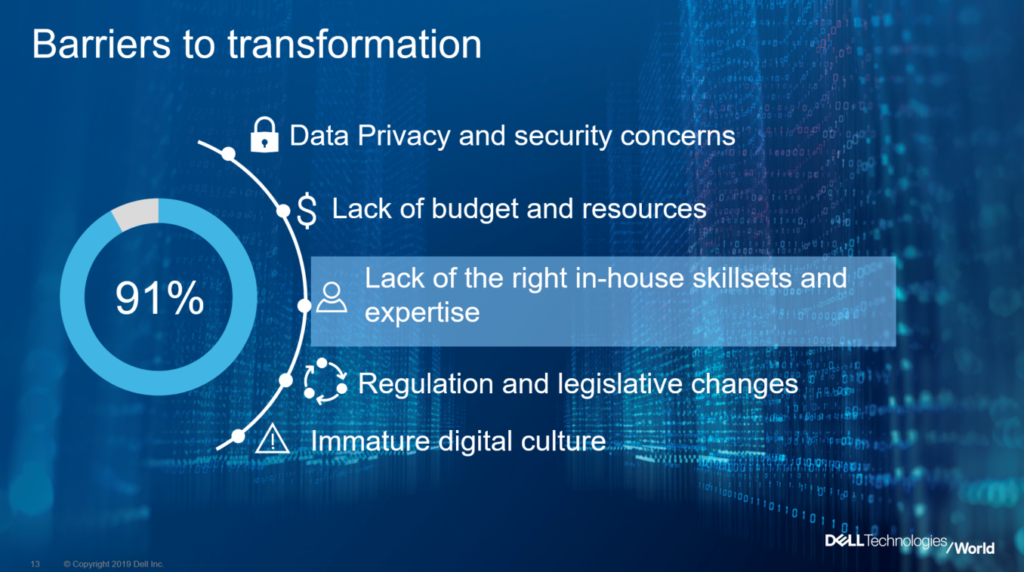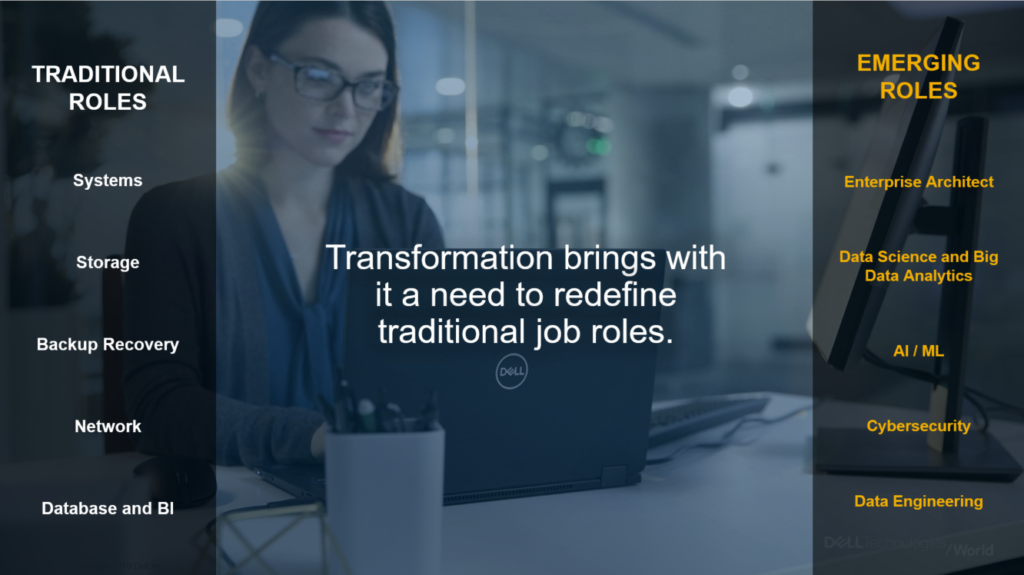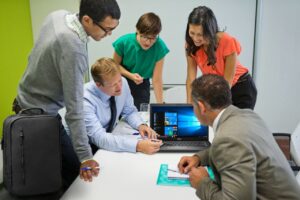Digital transformation occurs when an organization puts technology into the heart of its offerings to accelerate business and operations. It is happening and will continue to happen because the need is real, as evidenced by findings in the Digital Transformation Index (2016). Information gathered from 4,600 business leaders revealed 78% felt that transformation should be more widespread throughout the organization.
The action is already underway. A high percentage of the companies represented in the Dell Transformation Index are investing in these digital transformation areas:

However, digital transformation alone will not guarantee the desired business and operations successes. Workforce transformation that prepares for, accepts, and applies the many digital elements is crucial. In fact, one of the top five barriers that 91% of the DTI businesses face is lack of in-house skills and expertise.

IT Roles Aligned for Emerging Technologies
From a skills perspective, the many aspects of “digital transformation” are clearly tangible in IT. As organizations rapidly move from siloed legacy infrastructure to dynamic, multi-cloud environments, the enterprise becomes digitally oriented and employee skills become more critical. The days of single-function roles such as storage or server admin are being eclipsed by roles that span emerging technologies such as AI/ML, IoT, Blockchain, and RPA. New roles are emerging that did not previously exist: multi-cloud operator, data engineer, Enterprise Architect and infrastructure security specialist among the most prominent.

IT professionals stand to benefit by evolving their skills for these new roles. A recent CompTIA study shows that finding workers with skills/experience in emerging areas – e.g. 59% for AI/ML and IoT, 55% for cybersecurity, 55% for app development, 53% data management and analysis – is a top hiring challenge reported by employers.
Organizational Support in Skill Development
Given that, it’s an ideal time for team members to enhance their skills to take advantage of the new opportunities for growth – and they’ll need their companies’ support to do so. Engagements with Dell’s customers have shown that skills transformation is an integral responsibility of both the individual and the organization. Individuals must develop the required skills to keep pace with changing technology; the organization must encourage this skills development by providing the learning solutions.
This post is specifically bi-focal. In addition to emphasizing the importance of transformation of the workforce, it also highlights continuous learning as a key success factor to driving real transformation.

A Learning Culture Complements Transformation
Let’s spell out the key benefits for transformation of the workforce and transformation by the workforce.
Clearly, digital transformation is taking place at an ever-increasing rate. Ideally, an organization witnesses zero gap between its digital transformation and its workforce transformation. Such perfection is not likely. Hence, effort should be made to increase the pace of workforce learning, skill-developing, and transforming. The closer that rate of change is to the rate of digital change, the more successful the transformation overall.
Another value to workforce transformation is its contribution to human asset management. The healthier any business’s attention to the value of its employees – its human asset – the stronger its workforce, more effective its operations, and greater its success. Investing in workforce transformation targets many of the elements of human asset management:
| · Recruitment | · Onboarding |
| · Retention | · Development |
| · Talent Management | · Performance Management |

A learning culture results from giving attention to workforce transformation as a factor of human asset management. The presence of a learning culture satisfies ambitious individuals looking for opportunities to learn and grow. It also supports ready access for those in need of knowledge and skills development resources. Finally, a learning culture is proven to create motivated, high-performing teams and organizations.
- Deloitte (2016): Millennials view training and development as the most important job benefit (over flexible hours, cash bonuses, free healthcare, retirement funding, and vacation allowance).
- Peter Senge (The Fifth Discipline, 1990): “The rate at which organizations learn may become the only sustainable source of competitive advantage.”
- Jack Welch, former CEO at GE: “An organization’s ability to learn, and translate that learning into action rapidly, is the ultimate competitive advantage.”
- Dell’s market research study shows that 94% of employees tend to remain at a company that invested in their career development.
The nature of the current workforce – four generations simultaneously included – and the pace of change that requires new or additional learning, promote specific and diverse movement from the traditional classroom training.
Variety in Learning Methods
Flexible, blended modes of content delivery are expected by the workforce. The volume of workload, the nature of assignments, and increasing comfort with digital information drive individuals to want training in a variety of modalities. These include instructor-led classroom, virtual instructor-led, on-line video and e-learning, to name a few. Offering the full composite of these several modalities benefits the organization and its learning culture.
Social learning, a specific type of learning that is increasing in importance and utilization exponentially, includes both social-media and on-job, peer-to-peer experiences. Dell’s Gen Z survey of 12,000 individuals revealed that 75% of them preferred learning from others on the job to learning online. That is despite – or perhaps due to – their being digital natives with extensive familiarity with online learning. As well, 72% expressed that social media can be a valuable workplace tool. The several types of social learning too easily lend themselves to casual, informal, spontaneous ways to toss out information. A cautious, controlled, well-orchestrated program of social learning opportunities will better suit any company.
Companies will succeed and fail based on their ability to translate data into insights at record speed. The work, innovation and investment to support that is happening now. –Michael Dell
Learning Architect: Adopt Programmatic Approach to Continuous Learning
Learning has become a 24/7 endeavor. Continuous availability of learning modules in any of several forms offers both economy of scale and user-friendly accessibility. Meanwhile, desire for on-the-spot learning in 1-3-minute mini-casts is increasing in time with the spread of digital transformation.
Real transformation involves the essential elements of digital transformation as well as the personal elements of workforce transformation. Effectively combining those two elements enables identification of skills gaps through a prescriptive assessment process. The findings help define a continuous learning plan that puts the organization and the individual on the road to transformation. This commitment and a true learning culture ensure that the transformation evolves successfully over time.


